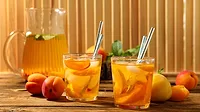Thirsting for Convenience
Thirsting for Convenience
By JENNIFER KOROLISHIN
C-store channel offers profit opportunity for
beverage-makers
Quenching your thirst is
as easy as popping into the nearest convenience store. Whether you’re
craving soda, beer, bottled water, iced tea, wine or an energy drink, the
local convenience store’s refrigerated case likely has exactly what
you want.
Beverages are big business for the convenience store
channel. The National Association of Convenience Stores’ (NACS) list
of the Top 10 convenience store product categories (ranked by 2004 sales)
includes three beverage entries — non-alcoholic packaged beverages
rank second (up from third place in 2003), beer ranks fourth and fluid milk
products rank eighth (up from ninth place in 2003).
Beverages are a natural for the grab-and-go
convenience store channel. While most stores carry six- and 12-packs of
carbonated beverages and beer, it’s also an ideal market for
single-serve beverages that busy customers can drink in the car or on the
run.
According to the NACS 2004 State of the Industry
report, sales of non-alcoholic packaged beverages were $15.1 million in
2003 (the latest figures available at presstime), accounting for 13 percent
of in-store sales. That segment includes carbonated soft drinks,
ready-to-drink iced tea, sports drinks, juice and juice drinks, bottled
water and alternative beverages. Beer sales totaled $12.7 million in 2003,
making up 10.9 percent of in-store sales, while fluid milk products
generated $3 million, for a total of 2.6 percent of in-store sales.
While the channelwide numbers are impressive,
beverages also post solid per-store sales in the convenience store
industry. Per-store sales of packaged non-alcoholic beverages averaged
nearly $115,000 in 2003, according to NACS. Beer averaged per-store sales
of almost $96,600.
“The convenience channel is the largest channel
for Anheuser-Busch in terms of both sales and market share. This
channel is extremely important to our marketing efforts,” says Bill
Laufer, vice president, convenience channel and trade relations for St.
Louis-based brewer Anheuser-Busch Inc., which sold 38.3 percent of all its
products in 2004 through convenience stores.
For Anheuser-Busch and other beverage-makers that sell
a large percentage of their products through convenience stores, targeting
marketing and promotions to the channel is a critical sales strategy.
“We tailor promotions and marketing to every
channel,” says Laufer. “The convenience store channel is ideal
for our ‘Freshness’ platform, and most c-stores work with us to
use that as a competitive advantage. We also use cross-category promotions
with products that have high purchase incidence in the c-store channel to
increase retail dollar ring and margins. Additionally, we use strategic
price promotions around packages that are in high demand in convenience
stores.”
In some cases, certain beverages are featured more heavily in the convenience store market, or
are created specifically for the channel. Modesto, Calif.-based winemaker
E&J Gallo launched its Sola Vista line last year to appeal to
convenience store customers. Sola Vista is sold in a 375-ml. bottle (a
half-bottle) in three varieties — Chardonnay, White Zinfandel and
Cool Red Zinfandel.
Wine generally makes up a smaller percentage of
convenience store sales — 0.3 percent in 2003 — but many store
operators are placing renewed emphasis on the category in an effort to
attract more female consumers, as well as those in the 25- to 35-year-old
demographic.
“Most of the major c-store chains are telling us
they want a tighter focus on the wine category,” says John Parke,
Gallo’s managing director, national retail chains. “They know
they have wine consumers in their stores, and they want to capitalize on
that.”
Additionally, Gallo has seen growth in 187-ml., or
quarter-bottles (similar to those available on airplanes), which encourages
single-serve consumption.
“You look at 7-Eleven’s move toward
upgrading their fresh food takeout and wine is absolutely a natural
addition to that,” Parke says. “We obviously want to continue
to grow our traditional table wine business in the channel, but to match up
well with that c-store consumer, we’ve had an added focus on
single-serve, which we see as a real opportunity.”
Brewers tend to take a category management approach in convenience stores, working with store
operators to choose the product mix that benefits retailers, consumers and
manufacturers.
“Convenience stores choose to feature the Bud
family of products more often than other channels because c-store operators
understand that the Bud family draws traffic and is the best way to enhance
beer category gross margin dollars,” Laufer says. “In addition,
Anheuser-Busch is bringing innovation to the category with new products
such as Budweiser Select and new single-serve packages and multi-packs to
maintain shopper interest in the category.”
Anheuser-Busch, like other beverage-makers, takes advantage of convenience stores’ assortment to cross-market its products with complementary brands,
including Jack Link’s beef jerky, and the Cape Cod and Pringles
potato chip brands. PepsiCo takes a similar tack, cross-marketing products
across its divisions, pairing Tropicana juices with Quaker Oats products,
as well as Pepsi soft drinks with Frito Lay snacks. BI
Looking for a reprint of this article?
From high-res PDFs to custom plaques, order your copy today!



